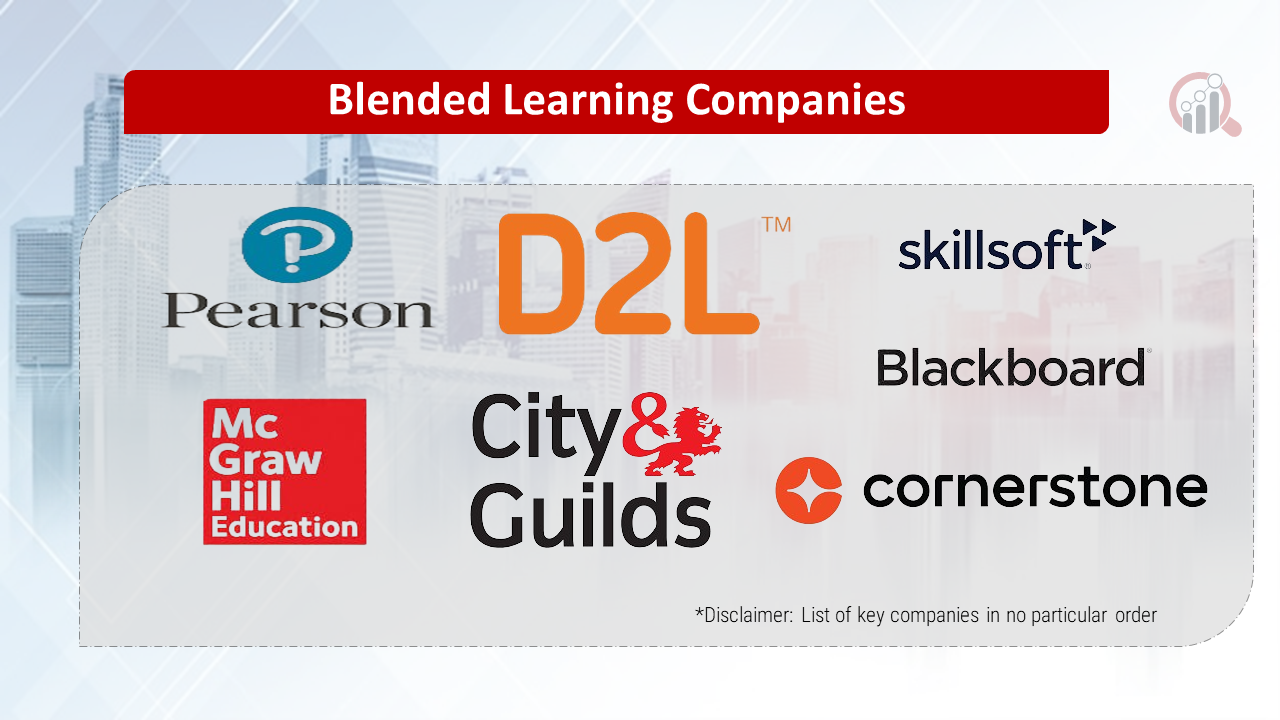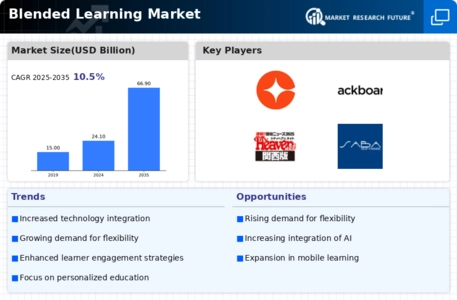Top Industry Leaders in the Blended Learning Market

Blended Learning Market: Dive into the Latest News and Updates
As the demand for flexible and engaging learning experiences grows, blended learning, a combination of online and offline learning methods, emerges as a leading approach. Understanding the key players, their strategies, and the factors influencing market share is crucial for navigating this dynamic and promising landscape.
Some of Blended Learning Companies Listed Below:
- Pearson Education
- McGraw-Hill Education
- Skillsoft Corporation
- D2L Corporation
- Cornerstone OnDemand Inc.
- NIIT Limited
- Blackboard Inc.
- City & Guilds Group
- Saba Software Inc.
- GP Strategies Corporation
- Aptara Corporation
Strategies Driving Market Growth:
- Focus on Personalized Learning: Leveraging technology to personalize learning paths, adapt content to individual needs, and provide targeted feedback enhances engagement and improves learning outcomes.
- Improved Learning Accessibility and Flexibility: Offering asynchronous online learning modules alongside in-person sessions caters to diverse schedules and learning styles, making education more accessible.
- Enhanced Collaboration and Interaction: Utilizing online forums, discussion boards, and interactive tools fosters active participation and collaboration between learners, enriching the learning experience.
- Focus on Data-Driven Insights and Analytics: Tracking learner progress, analyzing data from online modules, and providing personalized recommendations enables continuous improvement and optimizes teaching strategies.
Factors Influencing Market Share Analysis:
- Target Audience and Learning Needs: Understanding the specific needs and preferences of different learner segments, such as K-12 students, higher education learners, or corporate professionals, is crucial for tailoring solutions and achieving market success.
- Technology Integration and Interoperability: Seamless integration of online and offline learning components, with compatibility across devices and platforms, ensures a smooth user experience and promotes wider adoption.
- Content Quality and Curriculum Development: Offering high-quality, engaging, and curriculum-aligned content is essential for attracting learners and maintaining user satisfaction.
- Training and Support for Educators and Learners: Providing comprehensive training and support for educators and learners ensures effective implementation and facilitates adaptation to blended learning environments.
New and Emerging Companies:
- Focus on Microlearning and Gamification: Startups like Duolingo, Memrise, Kahoot! offer bite-sized learning modules and gamified experiences, making learning engaging and accessible for diverse audiences.
- Leveraging Artificial Intelligence: Companies like Amplify, Knewton, ALEKS utilize AI for personalized learning pathways, adaptive assessments, and real-time feedback, optimizing learning outcomes.
- Focus on Virtual Reality (VR) and Augmented Reality (AR): Companies like Merge VR, Arloon, Nearpod integrate VR and AR into blended learning experiences, creating immersive and interactive learning environments.
Current Investment Trends:
- Venture Capital Funding: Innovative startups developing personalized learning platforms, gamified experiences, and AI-powered solutions attract significant venture capital funding, fueling market diversification and innovation.
- Strategic Partnerships and Acquisitions: Established players are partnering with startups or acquiring niche expertise to expand their offerings and address emerging market needs.
- Investments in Educational Technology (EdTech) and Learning Analytics: Growing investments in EdTech research and development accelerate innovation in online learning platforms, data analytics tools, and personalized learning solutions.
Latest Company Updates:
- Jan 29, 2024: The European Commission releases a new strategy on personalized learning, highlighting the potential of blended learning to tailor education to individual needs.
- Jan 24, 2024: A growing focus on microlearning and gamification within blended learning programs is aimed at enhancing learner engagement and knowledge retention.









